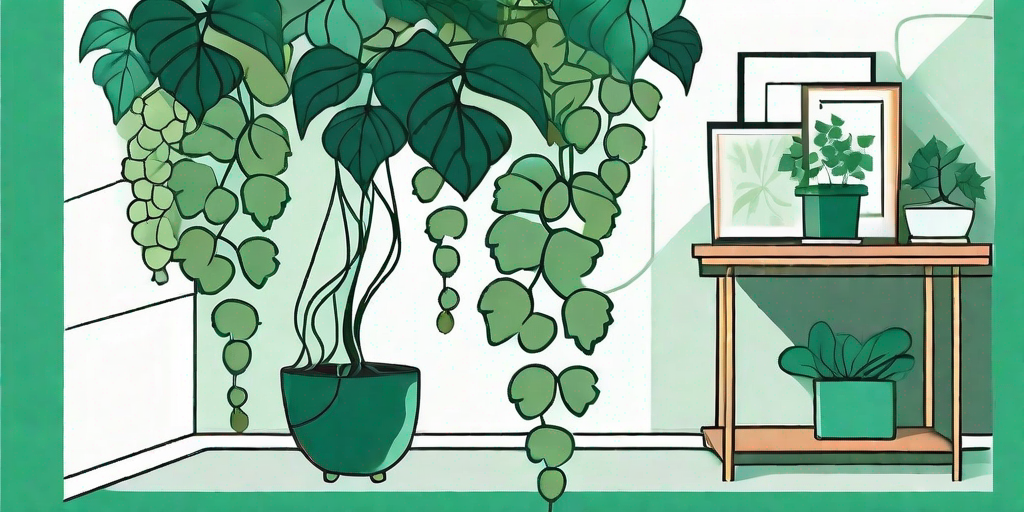
Welcome to the world of houseplants, where green is the new black and the grape ivy reigns supreme. If you're looking to add a touch of elegance and a dash of charm to your home, then you've come to the right place. So, buckle up, plant enthusiasts, as we dive into the lush, verdant world of the grape ivy houseplant.
What is a Grape Ivy Houseplant?
Before we start our botanical journey, let's get to know our green protagonist a little better. The grape ivy, or Cissus rhombifolia, is a fast-growing, evergreen vine that's part of the Vitaceae family. Yes, the same family that gives us our beloved wine. But don't get too excited, this plant won't be producing any grapes for your next wine night.
Native to South America, this plant has glossy, deep green leaves that resemble those of grapevines, hence the name. It's a popular houseplant choice due to its easy-going nature and its ability to bring a touch of the tropics into your home.
How to Care for Your Grape Ivy Houseplant
Light Requirements
The grape ivy is a bit of a diva when it comes to light. It prefers bright, indirect light but will throw a tantrum if exposed to direct sunlight. So, unless you want to deal with a sunburnt plant, keep it away from those scorching rays.
On the other hand, if your plant is not getting enough light, it will let you know by becoming leggy and sparse. In this case, you might want to move it to a brighter spot or consider getting a grow light.
Watering Needs
Like a true drama queen, the grape ivy likes to keep you guessing when it comes to watering. It prefers its soil to be kept evenly moist, but not waterlogged. Overwatering can lead to root rot, which is as nasty as it sounds.
On the flip side, underwatering can cause the leaves to wilt and drop. So, it's all about finding that perfect balance. A good rule of thumb is to water when the top inch of soil feels dry to the touch.
Temperature and Humidity
The grape ivy is a tropical plant, so it likes it warm and humid. It thrives in temperatures between 60 and 80 degrees Fahrenheit and high humidity levels. So, if you live in a dry climate, you might want to consider getting a humidifier to keep your plant happy.
And remember, this plant is not a fan of drafts or sudden temperature changes, so keep it away from air conditioners and heaters.
Common Problems and How to Solve Them
Yellow Leaves
If your grape ivy's leaves are turning yellow, it might be a sign of overwatering. Check the soil and adjust your watering schedule accordingly. If the problem persists, you might need to repot the plant in fresh soil.
Yellow leaves can also be a sign of nutrient deficiency. In this case, a balanced houseplant fertilizer should do the trick.
Leaf Drop
If your plant is dropping leaves like it's going out of style, it might be due to low light or temperature fluctuations. Make sure your plant is getting enough light and is kept away from drafts.
Leaf drop can also be a sign of underwatering. If the soil is dry, give your plant a good drink and it should perk right up.
FAQs
- Is the grape ivy toxic to pets?
Yes, the grape ivy can be toxic to pets if ingested. So, if you have curious fur babies, you might want to keep this plant out of their reach.
- How often should I fertilize my grape ivy?
The grape ivy doesn't require a lot of fertilization. Feeding it once a month during the growing season (spring and summer) should be enough.
- Can I propagate my grape ivy?
Absolutely! The grape ivy is easy to propagate through stem cuttings. Just make sure to use a rooting hormone to increase your chances of success.
Conclusion
And there you have it, folks! Everything you need to know to become a grape ivy guru. This plant might be a bit of a diva, but with the right care, it will reward you with lush, tropical beauty. So, go ahead, unleash the beauty of your home with the grape ivy houseplant. You won't regret it.
Remember, a happy plant is a happy home. So, keep those green thumbs up and happy planting!















